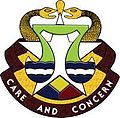Design
The 947,000-square-foot Carl R. Darnall Army Medical Center – one of the largest medical centers in the Department of Defense inventory – is nearly 60 percent larger than the original facility and includes a six-story hospital, three outpatient clinic buildings and three parking garages.
It is the last project completed under the American Recovery and Reinvestment Act, and also the program's largest contribution to the Department of Defense.
According to Major General John Uberti, deputy commanding general, III Corps and Fort Hood. The replacement hospital –
The new hospital's procurement was managed by the U.S. Army Corps of Engineers, and designed and built by a partnership of Balfour Beatty, McCarthy, HKS, and Wingler & Sharp. The Corps of Engineers core demand of the structure in design was durability. As a result, the facility is built on an entirely hardened concrete frame, surrounded by precast concrete panels. The design also called for hard wearing interior fittings, with entirely stainless steel flashings and double- and triple-pane windows. The building is also designed to be expanded as the years go by. When the floors were laid, accessible crawlspaces were built between each floor, with sufficient room for mechanics to easily conduct maintenance for HVAC, plumbing, medical gas system and a pneumatic tube system. The space allows future renovation and reconfiguring to occur floor by floor, with a standardized modular design in clinical spaces and floors which are adaptable to suit acuity levels and incremental growth. instead of needing to shut down hospital operations during construction.
For example, ambulatory care areas were designed to flex and adapt into adjacent areas with different functions. It is also designed to accommodate future technology driven by medical equipment advances.
Flexibility is an important part of the design. The medical center can grow both vertically and horizontally to keep up with the needs of soldiers and their families. Three stories can be added to the bed tower, and nearly 100,000 square feet of additional space can be added horizontally at the clinic level.
The medical center separates its services into what it calls 'portals of care', categorizing patient needs as primarily clinic-based or hospital-based. The hospital maintains a variety of service lines, but focuses especially on women's healthcare, orthopedics, and behavioral health. Major clinic-based portals of care contain primary and comprehensive departments, which include primary care, orthopedics and rehabilitation, women's outpatient services, emergency medicine, disability evaluation, surgery and multiple outpatient behavioral health clinics.
The facility opened in 2016, with Deputy Under Secretary of Defense John Conger, Congressman John Carter, and Fort Hood leadership in attendance. It is designed to be in service for the next 60 years. [5]














